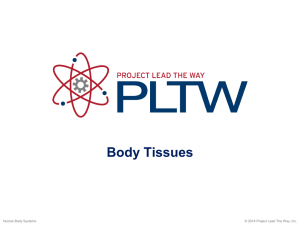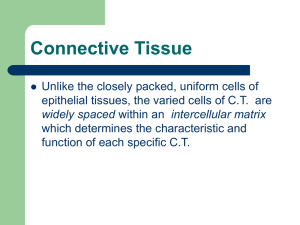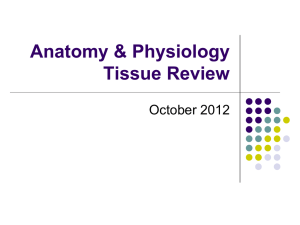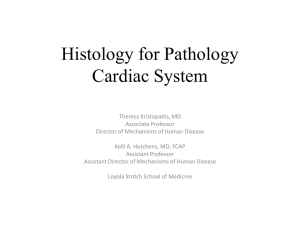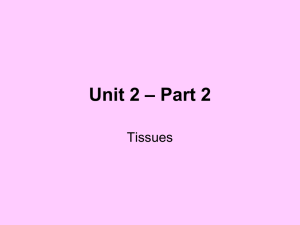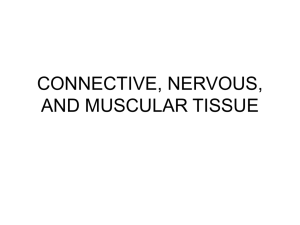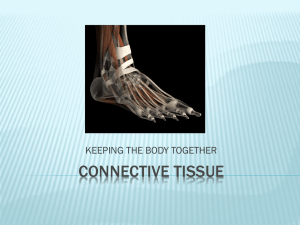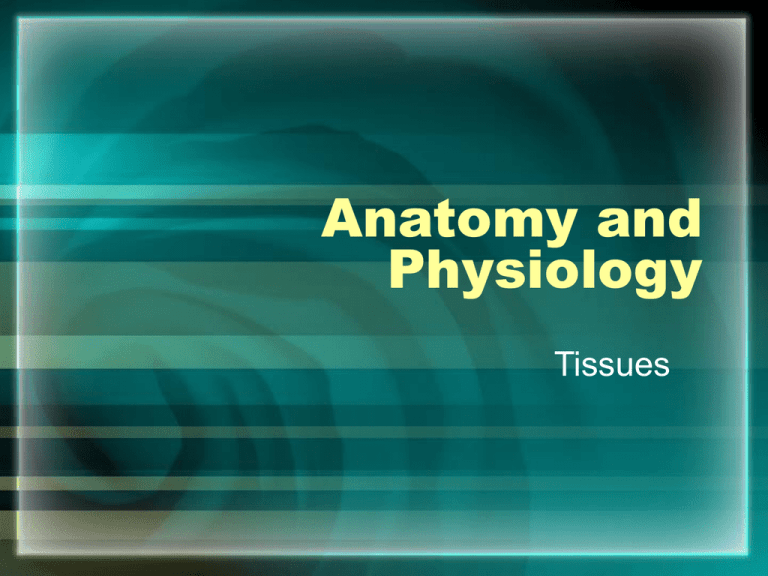
Anatomy and
Physiology
Tissues
Tissues Defined
•
•
1.
2.
3.
4.
Tissues are groups of cells that have
specialized structural and functional roles.
The tissues of the human body include 4
major types:
Epithelial
Connective
Muscle
nervous
Epithelial Tissues
• Characteristics:
• Epithelial tissues cover organs, form the
inner lining of body cavities, and line hollow
organs.
• They always have a side exposed to the
outside or to an internal open space.
• The underside is anchored to connective
tissue by a thin, nonliving layer, called the
basement membrane.
More characteristics:
• Epithelial tissues lack blood vessels;
nutrients diffuse from underlying
connective tissues.
• Division of epithelial tissues heals
injuries to skin.
• Epithelial cells are tightly
packed and form
protective barriers
(ex: skin).
Simple Squamous Epithelium
• Consists of a single
layer of thin, flattened
cells that fit tightly
together.
• Substances pass
easily through in
diffusion and filtration.
• Functions: lines air
sacs (alveoli), forms
walls of capillaries,
lines the insides of
blood and lymph
vessels, and covers
membranes that line
body cavities.
Simple Cuboidal Epithelium
• Consists of a single layer
of cube-shaped cells that
have spherical nuclei in
the center.
• Functions: covers the
ovaries, lines most of the
kidney tubules and the
ducts of certain glands,
functions in secretion
and absorption or
secretes glandular
products.
Simple Columnar Epithelium
• Are elongated cells
composed of a single
layer whose nuclei are
near the basement
membrane.
• Functions: lines the
uterus and most
organs of the digestive
tract, secretes
digestive fluids and
absorbs nutrients.
Microvilli
• Simple columnar cells are specialized for
absorption and often have tiny cytoplasmic
extensions called microvilli.
• Microvilli increase the surface area of the
cell membrane to increase absorption.
• Usually, flask-shaped glandular cells (goblet
cells) are scattered among the columnar
cells. These goblet cells secrete protective
mucus onto the free surface of the tissue.
Microvilli and Goblet Cells
• Microvilli
• Goblet Cells
Pseudostratified Columnar
Epithelium
• These cells appear stratified or layered, but
they are not. The nuclei are at different
levels.
• Found in the linings of the respiratory
system.
• Pseudostratified cells may possess cilia
which sweep mucus away, helping to move
the dust and microorganisms from entering
the respiratory system..
Pseudostratified continued:
• Lines the passages of the
respiratory system.
• Mucus-covered linings
are sticky and trap dust
and microorganisms that
enter with the air.
• Cilia move the mucus and
its captured particles
upward and out of the
airways.
Comparison
Stratified Squamous Epithelium
• Many cell layers make
this tissue thick.
• Cells divide in deeper
layers and push older
layers outward to
flatten.
• Forms the outer layer
of the skin (epidermis).
• Also, lines the mouth,
throat, vagina, and
anal canal.
Skin
• As skin cells age, a protein called
keratin accumulates which causes
them to harden as they die.
• Keratinization produces a covering of
dry, tough, protective material that
prevents water and other substances
from escaping and blocks various
chemicals and microorganisms from
entering.
Skin VS Organ Linings
• In other linings,
stratified squamous
epithelium does not
keratinize; it stays
soft and moist and
surface cells remain
alive.
Stratified Cuboidal
Epithelium
• Consists of 2 or 3 layers of
cuboidal cells that form the
lining of a lumen.
• Layering provides more
protection than a single
layer.
• -lines the larger ducts of
the mammary glands,
sweat glands, salivary
glands, and pancreas as
well as developing ovarians
follicles and seminiferous
tubules (parts of the
reproductive systems).
Stratified Columnar
Epithelium
• Consists of several
layers of cells with the
superficial cells
elongated and the
basal layers cubeshaped.
• Stratified columnar
epithelium is found in
the male urethra and
vas deferens, and in
parts of the pharynx.
Transitional Epithelium
• Specialized to change
in response to
increased tension.
• Forms the inner lining
of the urinary bladder
and lines the ureters
and part of the urethra.
• Forms a barrier that
prevent the contents of
the urinary tract from
diffusing back into the
internal environment.
• When the walls of the
bladder contract, the
tissue consists of
cuboidal cells; when
the organ is distended,
the tissue stretches.
Glandular Epithelium
• Composed of cells
specialized to
produce and
secrete substances
into ducts or body
fluids.
• Usually found within
columnar and
cuboidal epithelia
and constitutes a
gland.
Two Types of Glands
• Exocrine glands secrete their products
into ducts that open onto some internal
or external surface.
• Endocrine glands secrete their
products into tissue fluid or blood.
Three Types of Exocrine
Glands
1. Merocrine glands—
release watery, proteinrich fluids by exocytosis
2. Apocrine glands—lose
small portions of their
glandular cell bodies
during secretion
3. Holocrine glands--the
entire cell lyses during
secretion
Serous or Mucous Cells
• Most exocrine secretory cells are
merocrine, and are subdivided as serous
or mucous cells.
• Serous cells secrete watery fluid with a
high concentration of enzymes (serous
fluid).
• Mucous cells secrete thicker fluid rich in
the glycoprotein mucin and is called
mucus. Ex: linings of the digestive and
respiratory systems.
Connective Tissue Characteristics
• -bind structures, provide support and
protection, serve as frameworks, fill spaces,
store fat, produce blood cells, protect
against infections, and help repair tissue
damage.
• An abundance of intercellular material
(matrix) is between connective tissue cells.
• Most have good blood supply; some are
rigid (bone) while others are flexible
(areolar).
Major Connective Cell Types
• Fibroblasts—the most common type of
fixed cell in connective—large, starshaped
• Macrophages—originate as white blood
cells—are specialized to carry out
phagocytosis and can move around
• Mast cells—located near blood vessels,
can release heparin to prevent blood
clotting and histamine, which promotes
reactions of inflammation and allergies.
Connective Tissue Fibers
•
1.
2.
3.
3 types:
Collagenous fibers
Elastic fibers
Reticular fibers
Collagenous fibers
• Thick threads of the protein
collagen grouped in long, parallel
bundles.
• -important components of body
parts that hold structures together
Ex: ligaments and tendons
• -ligaments connect bones to bones
• -tendons connect muscle to bones
• -found in dense connective tissue
and are also called white fibers
Elastic Fibers
• -composed of a protein
called elastin
• -thin fibers that branch to
form complex networks.
• -Stretch easily
• -found in vocal cords
• -also called yellow fibers
Reticular Fibers
• -thin collagenous, highly branched
fibers
• Form delicate supporting networks
in a variety of tissues
Categories of Connective
Tissues
•
•
•
•
•
•
•
•
1.
2.
3.
4.
5.
6.
7.
8.
Loose Connective Tissue
Adipose Tissue
Reticular Connective Tissue
Dense Connective Tissue
Elastic connective Tissue
Cartilage
Bone
Blood
Loose Connective Tissue
• Also called areolar tissue, loose
connective tissue forms delicate,
thin membranes throughout the
body.
• The cells, mainly fibroblasts, are
separated by a gel-like ground
substance that contains many
collagenous and elastic fibers that
fibroblasts secrete.
• Binds skin to underlying organs
and fills space between muscles.
Adipose Tissue
• Adipose tissue is fat.
• Adipocytes are cells that store fat as
droplets within their cytoplasm.
• As they enlarge, the nucleus is pushed to
one side.
• Adipose tissue lies beneath the skin,
between muscles, around the kidneys,
behind the eyeballs, in certain abdominal
membranes, on the surface of the heart,
and around certain joints.
Adipose Tissue continued
• Adipose tissue
cushions the joints
and some organs.
• It also insulates
beneath the skin
and stores energy
in fat molecules.
Reticular Connective Tissue
• Reticular connective
tissue is composed of
thin, collagenous fibers
in a 3-dimensional
network.
• It supports the walls of
certain internal organs,
such as the liver,
spleen, and lymphatic
organs.
Dense connective Tissue
• Dense connective tissue consists of many
closely packed, thick, collagenous fibers, a
fine network of elastic fibers, and a few
cells, most of which are fibroblasts.
• Collagenous fibers are very strong, enabling
the tissue to withstand pulling forces.
• It often binds body parts together, as parts
of tendons and ligaments.
• Dense connective tissue has poor blood
supply and is slow to heal.
Dense connective Tissue
continued
• Fibers of irregular dense connective
tissue are thicker, interwoven, and
more randomly organized.
• Dense Regular
dense irregular
Elastic Connective Tissue
• Elastic connective tissue mainly consists of
yellow, elastic fibers in parallel strands or in
branching networks.
• Between these fibers are collagenous fibers
and fibroblasts.
• This tissue is found in the attachments
between vertebrae of the spinal column and
in layers within the walls of certain hollow
internal organs (arteries, portions of the
heart, and larger airways).
Elastic Connective Tissue
Cartilage
• Cartilage is a rigid connective tissue.
• It provides support, frameworks,
attachments, protects underlying tissues,
and forms structural models for many
developing bones.
• Cartilage cells are called chondrocytes and
occupy small chambers called lacunae and
lie completely within the matrix.
• Cartilage matrix is composed of collagenous
fibers embedded in a gel-like ground
substance rich in a polysaccharide complex
and water.
Cartilage continued
• A cartilaginous structure is enclosed in
a covering of connective tissue called
perichondrium.
• Cartilage tissue lacks a direct blood
supply but obtain nutrients by diffusion.
• Cartilage heals slowly.
Cartilage Continued
•
•
•
•
Three types of cartilage
1. Hyaline cartilage
2. Elastic cartilage
3. Fibrocartilage
Hyaline cartilage
• Hyaline cartilage is the most
common type and looks
somewhat like white glass.
• It is found on the ends of
bones in many joints, in the
soft part of the nose, and in
supporting rings of the
respiratory system.
• Embryonic skeleton begins as
hyaline cartilage.
Elastic Cartilage
• Elastic Cartilage is
more flexible than
hyaline because
its matrix contains
many elastic
fibers.
• It provides
framework for the
external ears and
parts of the larynx.
Fibrocartilage
• Fibrocartilage, a very tough
tissue, contains many
collagenous fibers
• It is a shock absorber for
structures that are subjected
to pressure.
• It forms pads between the
individual bones of the
spinal column and cushions
bones in the knees and
pelvic girdle.
Bone
• Bone (osseous tissue) is the most rigid
connective tissue.
• Its hardness is due to mineral salts, such as
calcium phosphate and calcium carbonate
in its matrix.
• It also contain a great amount of collagen
for reinforcement.
• Bone internally supports body structures,
protects vital structures in the cranial and
thoracic cavities and is an attachment for
muscles.
Bone Continued
• Bone contains red marrow
which forms blood cells,
and it stores and releases
inorganic salts.
• Bone matrix is deposited
by bone cells, osteocytes,
in thin layers called
lamellae which form
concentric patterns around
capillaries within a central
or Haversian canal.
Bone continued
• Osteocytes and layers of intercellular
material clustered around a central
canal, form a cylinder-shaped unit
called an osteon or Haversian system.
• Each central canal contains a blood
vessel so it heals very quickly.
• Bone cells have many cytoplasmic
processes that extend outward and
pass through minute tubes in the
matrix called canaliculi.
bone
Blood
• Blood is composed of cells that are
suspended in a fluid intercellular matrix
called plasma.
• These cells include red blood cells,
white blood cells, and cellular
fragments called platelets.
• Red blood cells transport gases; white
blood cells fight infections; and
platelets are involved in blood clotting.
Blood
• Only the red blood cells function
entirely within the blood vessels.
• White blood cells typically migrate from
the blood through capillary walls and
enter connective tissues where they
carry on their major activities.
Blood
Muscle Tissues
• Due to their elongated shape, the cells
in muscle tissues are sometimes
called muscle fibers.
• Muscle tissue are contractile; they can
shorten and thicken.
• As they contract, muscle cells pull at
their attached ends to move body
parts.
Muscle Tissue
• There are three
types of muscle
tissues.
• 1. cardiac
muscle
• 2. skeletal
muscle
• 3. smooth
muscle
Cardiac Muscle
• Cardiac muscle is found only in the heart.
• Its cells are striated and joined end-to-end.
• The resulting muscle cells are branched and
interconnected in complex networks.
• Each cardiac muscle cell has a single
nucleus.
• An intercalated disc is a specialized
intercellular junction where one cell touches
another.
Cardiac Muscle Continued
• Cardiac muscle, like smooth
muscle, is controlled
involuntarily and can continue to
function without being
stimulated by nerve impulses.
• This tissue makes up the bulk of
the heart and pumps blood
through the heart chambers and
into blood vessels.
Skeletal Muscle
• Skeletal muscle forms muscles that
usually attach to bones and that are
controlled by conscious effort.
• It is often called voluntary muscle.
• Skeletal muscle cells are long—up to
or more than 40 nm in length—and
narrow—less than 0.1 nm in width.
• They contain alternating light and dark
cross-markings called striations.
Skeletal Muscle Continued
• Each muscle cell has many nuclei
(multinucleate).
• A message from a nerve cell can stimulate a
muscle cell to contract by causing protein
filaments within the muscle cell to slide past
one another.
• Then the muscle cell relaxes.
• Skeletal muscles move the head, trunk, and
limbs and enable us to make facial
expressions, write, talk, and sing as well as
chew, swallow, and breathe.
Skeletal Muscle continued
Smooth Muscle Tissue
• Smooth muscle tissue does not have
striations.
• Smooth muscle cells are shorter than
those of skeletal muscle and are
spindle-shaped, each with a single,
central nucleus.
• This tissue comprises the walls of
hollow internal organs such as the
stomach, intestines, urinary bladder,
uterus, and blood vessels.
Smooth Muscle continued
• Smooth muscle cannot be
stimulated to contract by
conscious efforts.
• Thus, it is called
involuntary.
• For example, smooth
muscle tissue moves food
through the digestive tract,
constricts blood vessels,
and empties the urinary
bladder.
Nervous Tissue
• Nervous tissues are found in the brain,
spinal cord, and peripheral nerves.
• The basic cells are called nerve cells,
or neurons.
• Neurons, among the more highly
specialized body cells, sense certain
types of changes in their surroundings
and respond by transmitting nerve
impulses along cellular processes to
other neurons or muscles or glands.
Nervous Tissue Continued
• Nervous tissues can coordinate, regulate,
and integrate many body functions.
• Nervous tissues includes neuroglial cells or
supporting cells.
• These cells support and bind the
components of nervous tissue, carry on
phagocytosis, and help supply nutrients to
neurons by connecting them to blood
vessels.
• They also play a role in cell-to-cell
communication.
Nervous Tissue

